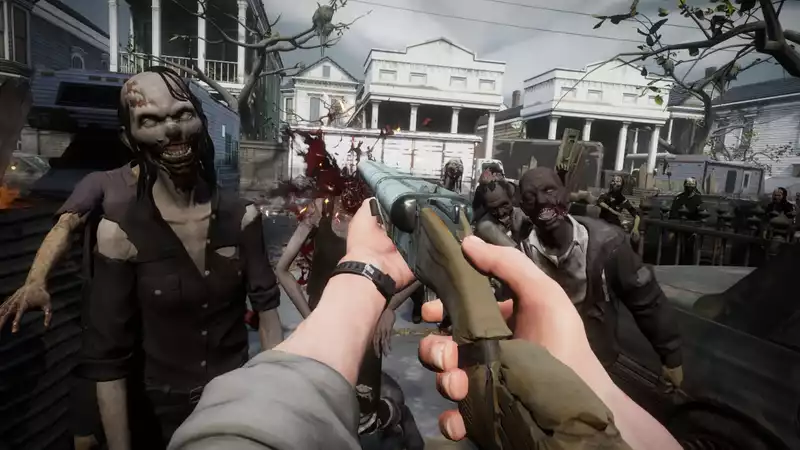In theory, we all know how to kill a zombie. It's easy, just destroy the brain. A bullet would suffice, but guns are noisy and zombies are attracted to noise. Ideally, you should walk up to them and pierce their skull with a knife. Quickly, cleanly, quietly.
Theoretically.
This is what is likely to happen the first time you kill a zombie in Saints and Sinners. You approach it and stab it with your knife, but it doesn't stick. The blade glances off and leaves a scar on the scalp, but has no effect. Skull. I didn't know skulls were so hard.
Now the zombie grabs you. You panic and stab the zombie in the face as if you were trying to pierce a bean on a plate. Meanwhile, your stamina is draining. When your stamina runs out, it's time for Mr. Flaky to eat. Finally, he pulls his arm back so far that his shoulder creaks, and with a sickening sound, the blade pierces bone and brain, and blood sprays down his arm.
Relief flows as the zombie goes limp. I pull the knife, but I can't pull it out. The blade has stabbed. The only weapon I have is stuck in this corpse's head. Meanwhile, two more zombies, one wearing a helmet, eagerly walk towards you.
Saints and Sinners' nuanced simulation of knife and skull interaction is both harrowing and remarkable. Not only does it make each zombie encounter subtly unique (and unsettling), but it effectively conveys your personal journey as a survivor in the world of The Walking Dead. After the disorienting horror of the initial kill, you will be buzzing with nervous adrenaline and convinced that you are at an insurmountable disadvantage. Over time, however, you will learn how to effectively dispatch the walkers.
This one mechanic alone would be enough to advance "Saints and Sinners". But that is only a small portion of the most mechanically rich VR game I have ever played. Set in New Orleans, the game puts you in the role of an unnamed survivor known as "The Tourist," tracking down a military bunker known as "The Reserve." From a contact trapped inside the Reserve (a man named Casey), you learn that it is filled with all the resources a survivor could want. However, the Reserve is also slowly filling with floodwaters. Meanwhile, the key to access the Reserve is in the possession of the vigilante and will not be handed over until he helps one of the two local factions fighting over the city get revenge on the Tower.
From his base in the cemetery, he travels to a different district of the city each new day to accomplish a specific objective, such as retrieving parts to repair a radio or gathering "information" from within the faction's base. At the same time, they must scavenge resources from the environment, acquiring everything from broken guns to discarded shoes and bringing them back to craft new weapons and equipment.
Saints and Sinners builds its game on a solid VR foundation. Most interactions are given the same care and attention as in melee combat. If wounded, you must bandage your arm to regain strength, or you can "disguise" yourself from a zombie by pulling out its internal organs and rubbing them on your clothes or skin, as in the cartoon. Firearms are also nicely presented, with authentic reloading mechanisms such as revolvers and double-barreled shotguns.
But what elevates Saints and Sinners above other VR games is that these individual interactions are integrated into a longer experience with both a neat story and, more importantly, a comprehensive game system. With each passing day, the supplies available in the world decrease and the number of zombies increases. In other words, creating new equipment is not merely a means of empowering oneself, but is essential to continuing to respond to ever-increasing threats.
This long-term problem is in direct conflict with the short-term dilemma. When we enter society, we have approximately 30 minutes before the towers ring the bells of every church in town and the streets become crawling with zombies. Once that happens, it's too late to be too picky about the resources we collect. Once back at the base, you need to prioritize which upgrades to make, whether it's a fancy new butcher knife or a home-cooked meal that will increase your stamina without causing health-damaging infections.
The result is a scuzzy, tense engine where every moment is critical, and although Saints and Sinners is a survival game concept, it definitely has more in common with Dishonored. It's a game that blends stealth and combat in an environment of constantly changing circumstances, where you plan your actions and are surprised by the results. No matter how much your knife skills improve, you will always play with a knot of anxiety in your stomach. [For example, you choose whether to help the Tower's guards rescue your brother from another faction, the Reclaimers, or whether to kill him yourself and help the Reclaimers get revenge on the Tower. However, while these choices affect the overall direction of the story, they are far superfluous compared to Telltale's narrative adventure.
My other complaints are mostly minor. The crafting system could be a bit more complex. The guns are perfectly fine, but not as intuitive or satisfying as melee weapons. The lack of a manual save system was frustrating at times, although there is a chance to regain lost loot if you die.
That's about it; "Saints and Sinners" is a great VR title and my favorite VR game since "Superhot". If you recently purchased a VR headset in anticipation of "Half-Life", give it a try: if you recently purchased a VR headset in anticipation of "Alyx", take it out of the box a month early and equip yourself for this game.
.

Comments